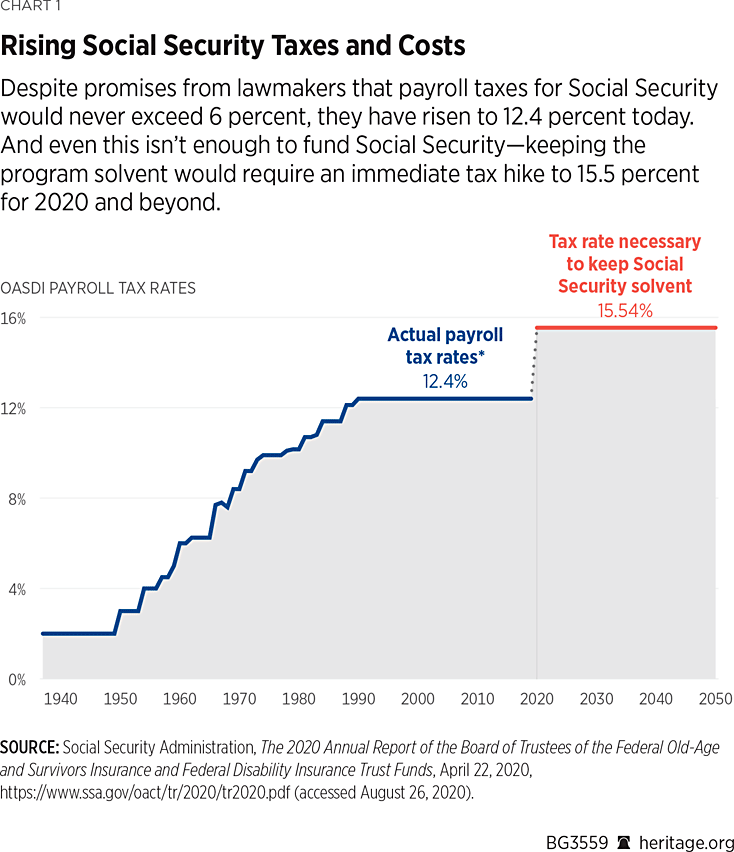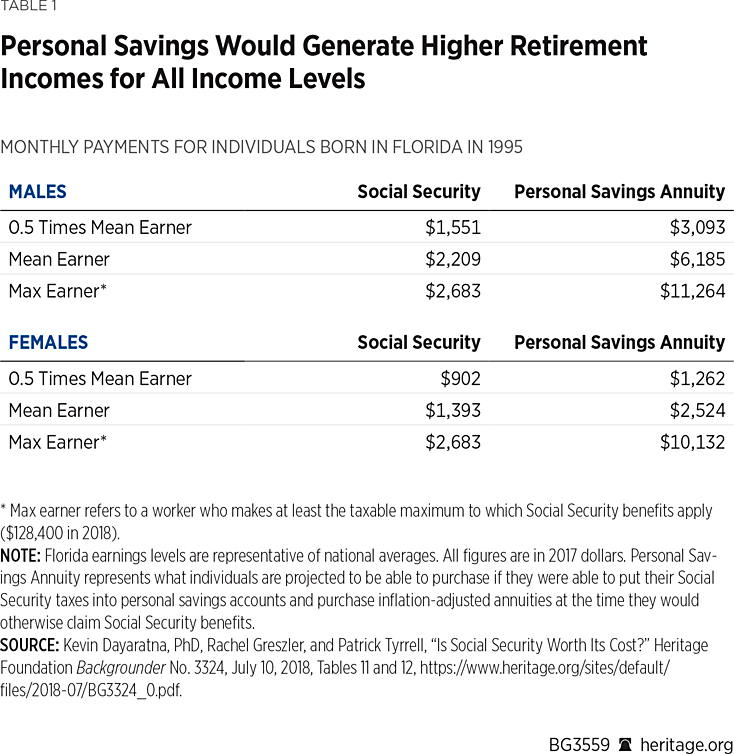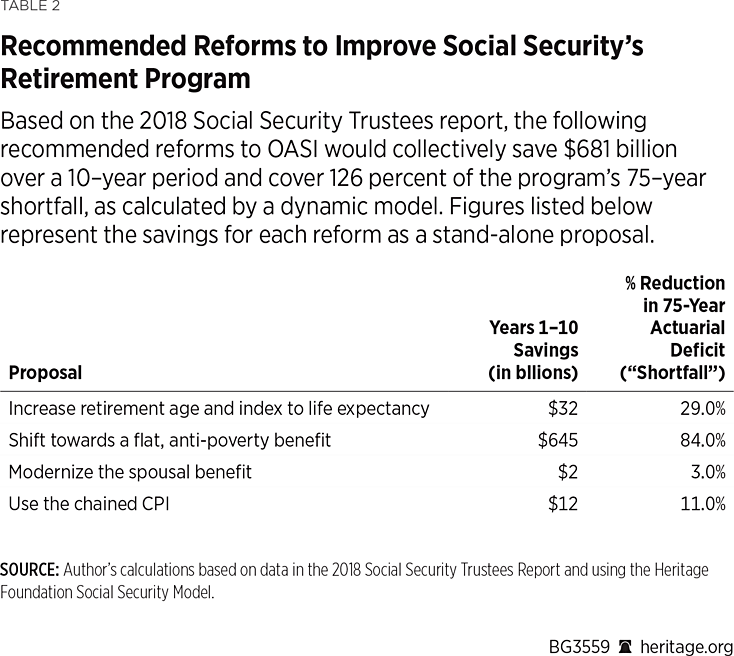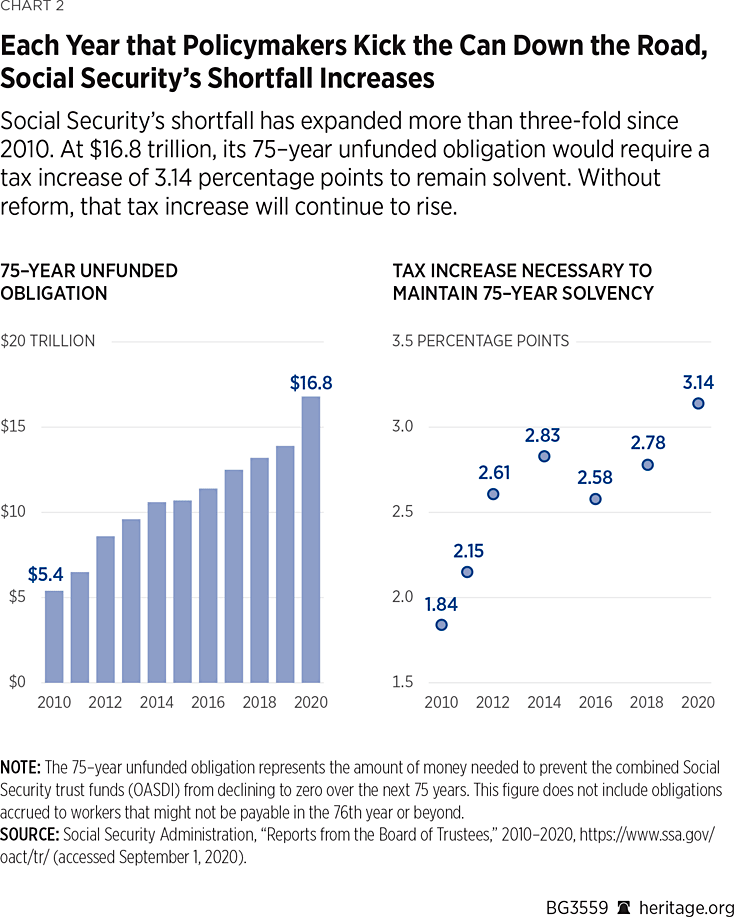Social Security is arguably America’s most popular federal government program. Yet, most Americans know very little about how Social Security works, and they do not realize what they give up in exchange for Social Security benefits. At the same time, they are increasingly uncertain about whether Social Security will be there for them in retirement.
Moreover, the very real possibility of large Social Security tax increases creates further uncertainty and distress. Founded with the goal of preventing poverty in old age, Social Security has grown far beyond its original intent. Its current structure—providing the largest benefits to those with the least need and continually rising costs over time—have transformed the program’s role from poverty prevention to intergenerational income redistribution. Unintended growth in Social Security taxes also restricts personal savings, which limits households’ choices, well-being, and wealth, all while dragging down economic growth. Reform proposals that further increase Social Security taxes will exacerbate these consequences.
To better provide for individuals in need, increase opportunities and autonomy for all households, reduce uncertainty, improve financial stability, and restore confidence in the U.S. economy and fiscal outlook, policymakers should promptly enact measures to gradually shift Social Security to a flat, anti-poverty benefit; apply a more accurate inflation index; slowly increase Social Security’s eligibility age and tie it to life expectancy; modernize the program’s spousal benefit; and give workers the option of having a greater ownership stake in their financial futures.
1. High Taxes, Government Control of Savings Limit People’s Freedoms and Opportunities
The federal government already takes 12.4 percent of workers’ earnings to finance Social Security, and the program’s insolvency threatens significant tax increases. Such a heavy burden restricts individuals’ and families’ ability to save, invest, and otherwise spend their money throughout their lifetimes. The median worker pays far more in Social Security taxes than he does in taxes to finance every other, non-Social Security function of the federal government,REF and Social Security taxes consume almost twice as much as the typical household spends on groceries.
That is not the way it was supposed to be. Social Security started out as a 2 percent tax and promised to never take more than 6 percent of workers’ paychecks. Today, it takes 12.4 percent and would require 15.5 percent to provide scheduled benefits.

Some lawmakers want to increase Social Security taxes by $1,200 per year for average earners, and to tack an additional 14.8 percent Social Security tax on high-income earners.REF
Social Security’s already heavy tax burden—$3,100 for someone making $25,000 per year and $6,200 for someone making $50,000—makes it difficult for lower-income and middle-income households to save for all sorts of live events. Instead of households being able to set money aside and use it in ways that are best for them—such as purchasing a home that will grow in value over time, being able to take time off from work to stay home with a new child, saving for a child’s education, starting a new business, or helping to support a family member in need—all of that money is locked up in Social Security. Many individuals who die before, or shortly after, they reach Social Security’s retirement age lose tens or hundreds of thousands of dollars that they paid into the system and that otherwise could have helped provide for their families. This fact disproportionately harms lower-income and African American workers who live significantly shorter lives, on average, than higher-income and white workers.
A recent study found that men in the lowest-income quartile had life expectancies of 10 years less than men in the top quartile, while women in the bottom quartile had life expectancies of five years less than women in the top quartile.REF Life expectancy at birth is about 3.5 years less for black Americans than for whites.REF Differences in life expectancy coupled with the fact that workers must pay a significant portion of their wages into a system that locks that money up until retirement likely contributes to wealth inequality in the United States. More than 19 percent of black men in the U.S. will die between ages 45 and 65, likely having paid tens, if not hundreds, of thousands of dollars in taxes to Social Security while receiving little or nothing in return.REF The inability to spend or bequest this money to finance things like a child’s or grandchild’s education, a home purchase, or to set aside a savings cushion to prevent future hardships exacerbates existing inequalities.
Moreover, regardless of life expectancy, different families face different optimal spending and savings rates over their lifetimes. A recent study by Andrew Biggs shows that the optimal spending and savings rate varies significantly between households with children and those without, yet Social Security prescribes the same tax rate and benefit formula to everyone.REF
Government programs that determine who can receive which benefits and under which circumstances leave individuals and families with less control over their future and with fewer opportunities to pursue what is best for them.
Stopping Potential Threats: Preventing Tax Increases, Limiting Government Control of Income and Savings. Congress should:
-
Not enact the Social Security 2100 Act. This proposal would expand taxes and government control over workers’ incomes and savings by increasing the Social Security tax by 2.4 percentage points, to 14.8 percent. This would cost a typical worker who makes $50,000 an extra $1,200 per year. With an additional 14.8 percent tax on higher-income earners, the act would increase the top federal income tax rate to 58.6 percent.REF Tacking on state income taxes in a high-tax state like California would lead to a top federal-plus-state tax rate of 68.9 percent in California.REF The proposal would also increase Social Security benefits immediately for everyone, regardless of income level, and even for individuals who are already retired and would not pay higher Social Security taxes. Under the Social Security 2100 Act, low-income workers would receive an additional $64,000 in lifetime benefits while millionaires would get a $171,000 boost in lifetime benefits. Middle-income and upper-income workers do not need higher Social Security benefits to keep them out of poverty in old age, and workers of all income levels would fare better by keeping the money that the Social Security 2100 Act would take from them.REF

-
Not raise or eliminate Social Security’s tax cap. Proponents of a bigger Social Security program advocate raising or eliminating Social Security’s taxable maximum thresholdREF as a way to raise revenues.REF Currently, about 6 percent of workers earn more than Social Security’s taxable maximum ($137,700 in 2020, with earnings above that not subject to Social Security taxes), but almost 20 percent of workers will have earnings above the taxable maximum at some point throughout their careers.REF Raising or eliminating the tax cap would reduce the household budgets of tens of millions of Americans,REF result in a top federal income tax rate of 56.2 percent,REF and a top combined state-plus-federal income tax rate of 66.5 percent.REF If combined with an overall Social Security payroll tax increase as proposed in the Social Security 2100 Act, these top income tax rates would rise to 58.6 percentREF and 68.9 percent,REF respectively. Even workers not directly affected by the higher taxes could experience reduced incomes as a result of lower capital that makes workers of all income levels less productive.
-
Not expand Social Security’s purpose. Social Security’s popularity, combined with its hidden costs, make the program ripe for further expansion, far beyond Social Security’s original purpose. Not only do many policymakers want to increase Social Security benefits in retirement, some want to treat Social Security as a personal piggy bank instead of a social insurance program. Already, Members of Congress have introduced bills that would allow workers to access their future benefits for non-retirement-related purchases, including paying off student loan debt and financing paid parental leave.REF Workers do need more flexibility and freedom to spend and save their money on what is best for them—but that should come from reducing Social Security’s costs instead of increasing its scope and allowing politicians in Washington to dictate when people can use their money and what they can spend it on, based on evolving “socially desirable” purposes of the time.
Improving the Status Quo: Minimizing Social Security’s Burdens. Congress should:
-
Reduce Social Security’s tax rate. A national program limited to preventing poverty in old age would cost only a fraction of Social Security’s $1.1 trillion annual price tag. Heritage Foundation experts estimateREF that shifting to a universal, anti-poverty benefit (along with a few other commonsense reforms) would reduce Social Security’s tax burden from 12.4 percent to 10.1 percent while also making the program solvent in the long run. The tax rate could further decline over time as benefits coalesce to a flat level, allowing workers to keep more of their own money to save and spend when and how they want. (See Table 2). In contrast, maintaining scheduled benefits would require the payroll tax to rise from 12.4 percent today to 15.7 percent in 2035, and to exceed 17 percent by 2080.REF

- Expand ownership of retirement wealth. In addition to lower Social Security tax rates, workers should have the option of partially opting out of Social Security and instead put a portion of their payroll taxes into a personal account—similar to the federal government’s Thrift Savings Plan for federal employees—that they own, can withdraw from early if needs arise, and can pass on to their family members. Heritage Foundation analysts estimatedREF that by putting Social Security taxes into a personal savings account invested in a relatively conservative mix of stocks and bonds, a low-income worker making $20,000 per year could accumulate $335,000 by retirement—providing 40 percent more income than Social Security can provide, and allowing the individual to pass on to heirs any amount he or she does not spend. The differences in savings, retirement incomes, and bequeathable assets would be even larger for middle-income and upper-income workers.
2. Social Security’s Excessive Size and Uncertain Future Make the Economy and People’s Incomes Smaller
Social Security taxes workers’ earnings today, in return for a monthly check if they reach Social Security’s eligibility age. Taxes on labor cause people to work less, and promises of future income cause people to save less. When people work less and save less, the economy and incomes grow more slowly.
Social Security’s eligibility criteria, benefit criteria, and tax treatment further reduce work and output across the economy. Despite increases in work capacity at older ages—due to health improvements over time and less physically demanding workREF—Social Security’s eligibility age causes people to retire earlier than they otherwise would.REF Because the government uses workers taxes to redistribute benefits to older workers and to increase other government spending, this displaces otherwise more productive investments that could increase workers’ incomes.
Moreover, uncertainty about Social Security’s future prevents individuals from optimizing their well-being now and in the future, and the threat of higher taxes prevents economic growth.REF The key advantage of Social Security is that it is supposed to provide guaranteed benefits; but what was once considered a sure thing is increasingly uncertain. In fact, for anyone under the age of 47, the only guarantee is that Social Security cannot provide its scheduled benefits. Even people already retired and receiving Social Security could have their benefits cut within 10 years to 15 years. Not surprisingly, more than 80 percent of Generation X and Millennials are concerned that Social Security will not be there for them when they retire.REF
Stopping Potential Threats: Not Letting Social Security Weigh Down Growth. Congress should:
-
Remember that the Social Security 2100 Act would reduce output and incomes. By taking an additional 2.4 percent to 14.8 percent from workers’ wages, the Social Security 2100 Act would reduce the U.S. labor supply, capital stock, productivity, wages, and economic output. Researchers at the University of Pennsylvania’s Wharton School of Business estimated that the Social Security 2100 Act would reduce economic output by 2.0 percent by 2049.REF In contrast, they estimated that a smaller, more targeted Social Security program—one with an updated retirement age, more accurate inflation adjustment, and smaller benefits for middle-income and upper-income earners—would increase output by 5.3 percent in 2049.
-
Not raise or eliminate Social Security’s tax cap. In addition to the consequences for individuals and families listed above, imposing a 12.4 percent or 14.8 percent tax increase on higher-level incomes would significantly distort the labor supply and capital stock, resulting in less labor, lower productivity, smaller incomes, and reduced economic growth. The Penn-Wharton Budget model projected that former Vice President Joe Biden’s plan to eliminate the tax cap on earnings over $400,000 (eventually subjecting all wages to Social Security’s tax) would reduce gross domestic product (GDP) and wages by 0.8 percent in 2050 (the equivalent of a $171 billion reduction based on 2019 GDP). Raising the payroll tax cap is an incredibly inefficient way to raise revenues; economic studies show that between 20 percent and 24 percent of the revenues gained would be lost due to a decline in non–Social Security taxes (as employers would reduce workers’ wages, resulting in lower federal, state, and local income and other tax revenues). Moreover, the behavioral consequences of reducing or eliminating the payroll tax cap could eliminate 50 percent or more of the initial, static revenue projections.REF
Improving the Status Quo: Restoring Social Security’s Solvency, Reducing its Drag on Output. Congress should:
-
Gradually shift Social Security to a flat benefit. Social Security was not intended to be an income-replacement program, but to prevent poverty in old age; and yet, it provides the largest benefits to the highest-income people with the least need. By very gradually shifting Social Security toward a universal, anti-poverty benefit, increasing benefits for low-income earners and reducing them for upper-income earners, Social Security’s solvency could be preserved and everyone could eventually pay less in Social Security taxes.
-
Update Social Security’s eligibility age and index it to life expectancy. When Social Security first began, the average life expectancy was only 61 years, meaning that the typical worker would not even receive Social Security benefits.REF Today, life expectancy has increased by 17 years and the typical worker receives benefits for nearly two decades.REF Improved health and work capacity means that the average individual can work longer than before. Policymakers should gradually increase Social Security’s eligibility age and index it to life expectancy.
-
Use a more accurate inflation index. The current inflation measure used by the Social Security Administration, the Consumer Price Index for Urban Wage Earners and Clerical Workers (CPI-W), is based on prices paid by less than a third of the population, and it fails to account for how people respond to changes in prices. There is bipartisan agreement among many policymakers and economists that the chained CPI is a more accurate index for calculating changes in the cost of living and it should replace the outdated and inaccurate CPI-W.REF
-
Let workers opt out of Social Security’s earnings test. Social Security’s misunderstood earnings test is perceived by workers as a 50 percent tax on their earnings, which results in those subject to the earnings test working and earning less than they otherwise would.REF Policymakers should allow individuals to opt out of the earnings test—giving them the choice between (1) having their benefits taxed in exchange for higher future Social Security benefits, and (2) not being taxed and forgoing higher future benefits.REF This would not alter Social Security’s solvency, but would give individuals more control over their finances, with the additional positive impact of increasing the amount of output produced by older Americans.
3. Hidden Costs, Intergenerational Redistribution, and Lost Investment Returns
Most people do not recognize the true cost of Social Security. For starters, they only see the 6.2 percent of their pay that is withheld from their paychecks (and many people do not actually look at their paychecks or file their taxes themselves), while the other 6.2 percent that their employer pays on their behalf remains hidden. Yet, economists agree that workers typically bear the full 12.4 percent cost because what employers pay would otherwise go to workers in the form of higher compensation.
Since the money is automatically withheld, workers do not realize what they could do if they had that money—things like buying a home in a better school district, paying for their child’s education, or saving for a rainy day or for retirement. A recent analysis shows that the optimal savings rate is actually much lower for families with children than families without children.REF Yet, redistributing income from workers to retirees prevents individuals and families from making decisions that could maximize their opportunities and well-being.

Moreover, because every dollar collected in Social Security taxes goes immediately out the door to pay benefits, individuals lose out on the opportunity to receive a positive rate of return over time. This is unfair to current workers and unhelpful to the American economy because shifting incomes from younger to older generations displaces savings, reduces productivity and output, and results in smaller incomes for younger and future workers. According to a Heritage Foundation study, this lack of opportunity to invest the money that young workers are paying in Social Security taxes means that someone earning $20,000 per year will receive $4,320 less from Social Security than she could have received from saving and investing her Social Security taxes. For someone making $60,000 per year, the difference between Social Security benefits and having been able to invest Social Security taxes is $47,712 per year.REF
Stopping Potential Threats: Refusing to Tolerate Inaction. Neither Congress nor the Administration should ignore Social Security’s enormous and threatening shortfalls.
-
Failure to enact reforms today increases future costs. Each year that policymakers fail to act adds trillions of dollars in additional costs for future taxpayers. Between 2010 and 2020, Social Security’s 75-year shortfall more than tripled, from $5.4 trillion to $16.8 trillion.REF The Social Security tax increase necessary to finance those shortfalls rose from 1.84 percent in 2010 to 3.14 percent in 2020;REF for someone making $50,000 per year, that is the difference between paying an extra $920 per year in taxes and paying an extra $1,570 per year. That figure will continue to rise the longer policymakers wait.
-
Delay of necessary reforms increases risk of financial crisis, retiree benefit cuts. No one wants to cut Social Security benefits for retirees, but the cost of maintaining scheduled benefits rises each year that lawmakers fail to enact reforms. Coupled with the enormous U.S. debt—recently exacerbated by COVID-19 spending—the U.S. faces a not insignificant risk of a fiscal crisis. If that occurs, it will be all the more difficult to prevent Social Security cuts for workers already in retirement, which could exacerbate hardships for low-income retirees.
Improving the Status Quo: Reducing Uncertainty, Enhancing Ownership. Congress should:
-
Reduce uncertainty about Social Security’s future so that people can make optimal choices. Most people have little concept of how much Social Security will provide for them until they are very close to retirement, and over 80 percent of Generation X and Millennials are concerned that Social Security will not be there for them when they retire.REF Uncertainty prevents people from making the choices that would be best for them, such as how much they need to save on their own, what they can safely afford while raising children, and how long they will need to work. Policymakers should enact reforms that put Social Security on a path to long-run solvency, specifying with near-certainty the amount that individuals can expect to receive during retirement. Heritage Foundation experts estimate that a smaller, better targeted program would eliminate Social Security’s shortfalls and also reduce the program’s tax burden by about 20 percent.REF
-
Give workers an ownership option in Social Security. As the Supreme Court ruled in Flemming v. Nestor,REF individuals have no legal claim to their scheduled Social Security benefits; Congress can change or take away those benefits at any time.REF Although drastic and rapid changes are unlikely, many workers would rather be in charge of, and actually own, their retirement savings. Workers should have the choice of either contributing the entirety of their 12.4 percent payroll tax to Social Security and receiving whatever benefit the program can provide when they retire, or putting a portion into their own personal account that would increase in value over time and could be used to purchase an annuity like what Social Security provides, to withdraw funds from as needed during retirement (potentially sooner) or pass them on to their family members. Due to Social Security’s massive shortfalls, individuals who choose to set aside part of their Social Security taxes in an account they own, instead of receiving Social Security’s traditional benefits, would still need to contribute a substantial portion of their earnings to the Social Security program. That portion—similar to a legacy tax—would decline over time if policymakers enact reforms to put Social Security on a path to long-term solvency.
Conclusion
Social Security, as past generations and current retirees have experienced it, is simply not possible for current workers and future generations. The program’s excessive growth imposes significant burdens on younger generations, and tackling Social Security’s enormous unfunded obligations will exacerbate those burdens.
Just how much younger and future generations will have to bear, however, will directly align with Social Security’s size and scope—a bigger program will take more in taxes and limit households’ control over their lifetime finances, while a smaller program will reduce taxes and give households more options to make lifetime choices that align with their unique circumstances and goals. Moreover, by shifting part of workers’ tax dollars—through lower Social Security taxes and an option to own and invest part of their Social Security taxes—away from Social Security’s pay-as-you-go structure to one that allows individuals to earn a positive rate of return over time (a return that reflects actual productivity growth from investments as opposed to extracted income from younger workers), all Americans could benefit from productivity and income gains. This shift could particularly benefit lower-income households by reducing income inequality and wealth inequality in the U.S.
Despite Social Security’s enormous unfunded obligations, it is actually possible to make Social Security solvent, to increase benefits for lower-income workers, and to return more income and greater control to individuals. Doing so should be a priority for the 117th Congress, and the next Administration should acknowledge the need for reform and provide leadership in constructing and advocating commonsense solutions.
Rachel Greszler is Research Fellow in Economics, the Budget, and Entitlements in the Grover M. Hermann Center for the Federal Budget, of the Institute for Economic Freedom, at The Heritage Foundation.



